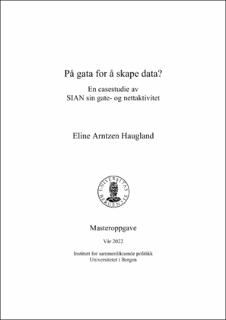| dc.description.abstract | It has been argued that the far-right has moved their street activism to online platforms. While the radical right and the extreme right were active in the streets 20 years ago, they have primarily shifted their activism to the Internet and social media today. However, this has changed among some groups, particularly the anti-Islamic radical right, as their street activism in recent years has experienced a reinvigoration. Stop Islamisation of Norway is currently the most active far-right organization in Norway, with a visible street presence and often in the media spotlight. The organization is among those that have experienced the greatest growth and presence on the Internet, more specifically on Facebook. The current research on the far right, however, has primarily focused on elections, parties, extremism and political violence, and explanations on the micro and macro level. This thesis investigates two research questions: (1) How is the Internet activity from SIAN supporters on Facebook affected by the street protests and other activities that SIAN orchestrate? And (2) What are SIAN’s attitudes towards the street- and Internet activity, and the interaction between these forms of activity? I build my theoretical argument on social movement theory, existing research on the far-right extra-parliamentary protest mobilization, as well as literature on the affordances of the Internet. The research questions are examined by employing a mixed methodological approach. Using Facebook data collected through CrowdTangle, I examine whether online activity increases on the days that SIAN has held a protest. The methodological approach I use to investigate this question is through counterfactual analysis, using matching and linear regression. Findings from the analysis indicate that protests have a positive effect on online activity among supporters of SIAN in their Facebook group. The second research question involves an in-depth interview with the leader of SIAN to examine aspects related to their street- and online activity. Findings from the interview indicate that SIAN has very clear and defined goals. Street protests are perhaps the most important tool for achieving their goals. Digital platforms play a key role in sharing information and announcing future demonstrations. There is, however, clear skepticism towards Facebook. The increased online activity in the Facebook group that follows the street protest mobilization appears to be an unintended effect. | |
